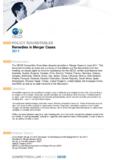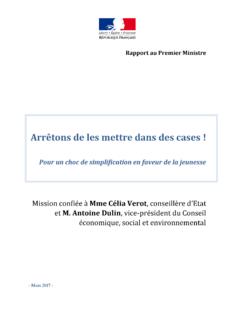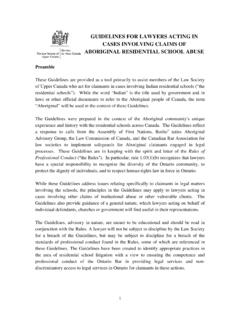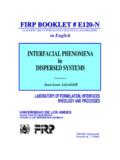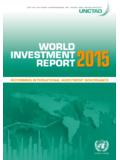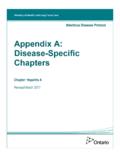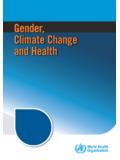Transcription of The WHO Recommended
1 The WHO Recommended classification of pesticides by HazardandGuidelines to classification 2009 WHO Library Cataloguing-in-Publication DataWorld health WHO Recommended classification of pesticides by hazard and guidelinesto classification : pesticides toxicity. 2. pesticides classification . 3. Hazardous substances classification . 4. Guidelines. I. International Programme on Chemical Safety. II. 978 92 4 154796 3 (NLM classification : WA 240)ISSN 1684-1042 world health organization 2010 All rights reserved. Publications of the world health organization can be obtained from WHO Press, world health organization , 20 Avenue Appia, 1211 Geneva 27, Switzerland (tel.: +41 22 791 3264; fax: +41 22 791 4857; e-mail: Requests for permission to reproduce or translate WHO publications whether for sale or for noncommercial distribution should be addressed to WHO Press, at the above address (fax: +41 22 791 4806; e-mail: The designations employed and the presentation of the material in this publication do not imply the expression of any opinion whatsoever on the part of the world health organization concerning the legal status of any country, territory, city or area or of its authorities, or concerning the delimitation of its frontiers or boundaries.))
2 Dotted lines on maps represent approximate border lines for which there may not yet be full mention of specific companies or of certain manufacturers products does not imply that they are endorsed or Recommended by the world health organization in preference to others of a similar nature that are not mentioned. Errors and omissions excepted, the names of proprietary products are distinguished by initial capital reasonable precautions have been taken by the world health organization to verify the information contained in this publication. However, the published material is being distributed without warranty of any kind, either expressed or implied. The responsibility for the interpretation and use of the material lies with the reader.
3 In no event shall the world health organization be liable for damages arising from its use. Cover design: J-C. Fattier, by Wissenchaftliche Verlagsgesellschaft mbH, Stuttgart, WHO Recommended classification OF pesticides BY HAZARD AND GUIDELINES TO classification 2009 The WHO Recommended classification of pesticides by Hazard was approved by the 28th world health Assembly in 1975 and has since gained wide acceptance. When it was published in the WHO Chronicle, 29, 397-401 (1975), an annex, which was not part of the classification , illustrated its use by listing examples of classification of some pesticidal active ingredients and their formulations. Later suggestions were made by Member States and pesticide registration authorities that further guidance should be given on the classification of individual pesticides .
4 Guidelines were first issued in 1978, and have since been revised and reissued every few until the present revision the original guidelines approved by the world health Assembly in 1975 have been followed without amendment. In December, 2002 the United Nations Committee of Experts on the Transport of Dangerous Goods and on the Globally Harmonized System of classification and Labelling of Chemicals (UNCETDG/GHS) approved a document called The Globally Harmonized System of classification and Labelling of Chemicals with the intent to provide a globally-harmonized system1 (GHS) to address classification of chemicals, labels, and safety data sheets. The GHS (with subsequent revisions) is now being widely used for the classification and labeling of chemicals worldwide.
5 For this revision of the classification the WHO Hazard Classes have been aligned in an appropriate way with the GHS Acute Toxicity Hazard Categories for acute oral or dermal toxicity as the starting point for allocating pesticides to a WHO Hazard Class (with adjustments for individual pesticides where required). It is anticipated that few of the more toxic pesticides will change WHO Hazard Class as a result of this change. As has always been the case, the classification of some pesticides has been adjusted to take account of severe hazards to health other than acute toxicity (as described in Part II). The GHS Acute Toxicity Hazard Category for each pesticide is now presented alongside the existing document is arranged as follows:Part I: Overarching principles for the classification of pesticides as Recommended by the world health Assembly.
6 These principles continue to apply, but the world health Assembly Resolution envisaged that the classification criteria might need to be developed with time and increasing experience. The guide-points originally proposed in 1975 are now being aligned with the corresponding Acute Toxicity Hazard Categories from the II: Guidelines to classification . Individual products are classified in a series of tables, according to the oral or dermal toxicity of the technical product. The tables are subject to review toxicity values are intended to be a guide only. Formulations should be separately classified using the methods set out on pages 4 (single technical product) and 7 (mixtures) and the table in Part I. To assist in the classification of formulations, an annex is provided giving numerical tables from which the classification may also be See on Part II of the document are welcome, together with proposals for new entries.
7 These should be addressed to the International Programme on Chemical Safety, world health organization , 1211 Geneva 27, Switzerland, and should include supporting data on the compound being commented on or document is a revision of the document previously issued as ISBN 92 4 154663 I Recommended classification OF pesticides BY HAZARDE xtract from WHO Chronicle, 29: 397-401 (1975)In 1973, the WHO Executive Board asked the Director-General of WHO to take steps to develop a tentative classification of pesticides that would distinguish between the more and the less hazardous forms of each pesticide. A proposal for a WHO Recommended classification of pesticides by hazard was accordingly prepared, taking into account the views of members of the WHO Expert Advisory Panel on Insecticides and other expert advisory panels with special competence and interest in pesticide technology, as well as the comments of WHO Member States and of two international agencies.
8 This proposal was adopted by the Twenty-eighth world health Assembly, which Recommended the use of the classification by Member States, international agencies, and regional text below is reproduced from the Proposal2 which was adopted by the world health Assembly in hazard referred to in this Recommendation is the acute risk to health (that is, the risk of single or multiple exposures over a relatively short period of time) that might be encountered accidentally by any person handling the product in accordance with the directions for handling by the manufacturer or in accordance with the rules laid down for storage and transportation by competent international classification based on biological data can never be treated as final. In the assessment of biological data, honest differences of opinion are inevitable and most borderline cases can be reclassified in an adjacent class.
9 Variability or inconsistency in toxicity data due to differences in susceptibility of test animals, or to experimental techniques and materials used can also result in differing assessments. The classification criteria are guide-points intended to supplement but never to substitute for special knowledge, sound clinical judgement or experience with a compound. Reappraisal might be necessary from time to of classificationThe classification distinguishes between the more and the less hazardous forms of each pesticide in that it is based on the toxicity of the technical compound and on its formulations. [In particular, allowance is made for the lesser hazards from solids as compared with liquids.]3 The classification is based primarily on the acute oral and dermal toxicity to the rat since these determinations are standard procedures in toxicology.
10 Where the dermal LD504 value of a compound is such that it would place it in a more restrictive class than the oral LD50 value would indicate, the compound will always be classified in the more restrictive class. Provision is made for the classification of a particular compound to be adjusted if, for any reason, the acute hazard to man differs from that indicated by LD50 assessments Official Record of the world health organization 1975, , Part 1, Note:- this distinction is not made in the GHS and no longer applies to the WHO Classification4 The LD50 value is a statistical estimate of the number of mg of toxicant per kg of bodyweight required to kill 50% of a large population of test of the criteria for classification (a) Where it is shown that for a particular compound the rat is not the most suitable test animal (for example, if another species is conspicuously more sensitive or more closely resembles man in its reaction) then the classification of that compound should take this into account.










